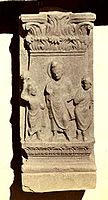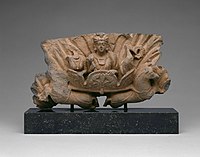Indo-Corinthian capital
Right image: An Indo-Corinthian capital with a palmette and the Buddha at its centre, 3-4th century, Gandhara.
Indo-Corinthian capitals are
Corinthian design
Indo-Corinthian capitals display a design and foliage structure which is derived from the academic
Figurines

Indo-Corinthian capitals also incorporated figures of the
Figural additions are very common in the classical world, and from an early period, usually take the form of heads or busts, but the Gandhara treatment is original in that the acanthus leaves form a canopy over it.[2]
Combinations with Buddhist architecture
Indo-Corinthian capital were also used in combination with architectural elements, such as Buddhist stupas. One of the best example was excavated and reconstituted at Sirkap.
Perhaps the most notable divergence from the western concept of function occurs at Kalawan,
Taxila, where a large acanthus capital set on a lotus base was inserted between the conventional square basement and cylindrical dome of a votive stupa.[2]
Further, in the art of Gandhara, Indo-Corinthian capitals on top of separating pilasters are used extensively in narrative friezes of the life of the Buddha. This usage continued as late as the 5th century.
Gallery
-
Base of pillar, Indo-Corinthian capitals and elephants from base of stupa, Jamal Garhi
-
An Indo-Corinthian capital from theTurin City Museum of Ancient Art).
-
Indo-Corinthian capital representing a Buddhist devotee wearing a Graeco-Roman coat with .
-
A pilaster decorated by a Corinthian capital and a female figurine, Athens, 2nd-1st century BCE.
-
The Buddha, within the foliage of a Corinthian capital.
-
Series of Indo-Corinthian capitals from Jamal-Garhi.
-
A Buddhist triad flanked by two pilasters with Indo-Corinthian capitals, Gandhara, 3rd century CE.
-
Indo-Corinthian canopy at theChakhil-i-Ghoundi stupa, Hadda.
-
Small Gandhara architectural pillar
-
Capital with central quadriga. Butkara Stupa.
-
Indo-Corinthian capital featuring the charriot-driving sun god Surya. Gandhara, 2nd century CE.
See also
References
- ^ Errington, Elizabeth (2017). Charles Masson and the Buddhist Sites of Afghanistan: Explorations, Excavations, Collections 1832–1835. British Museum. pp. 156–159.
- ^ ISBN 0-9518399-1-8.














